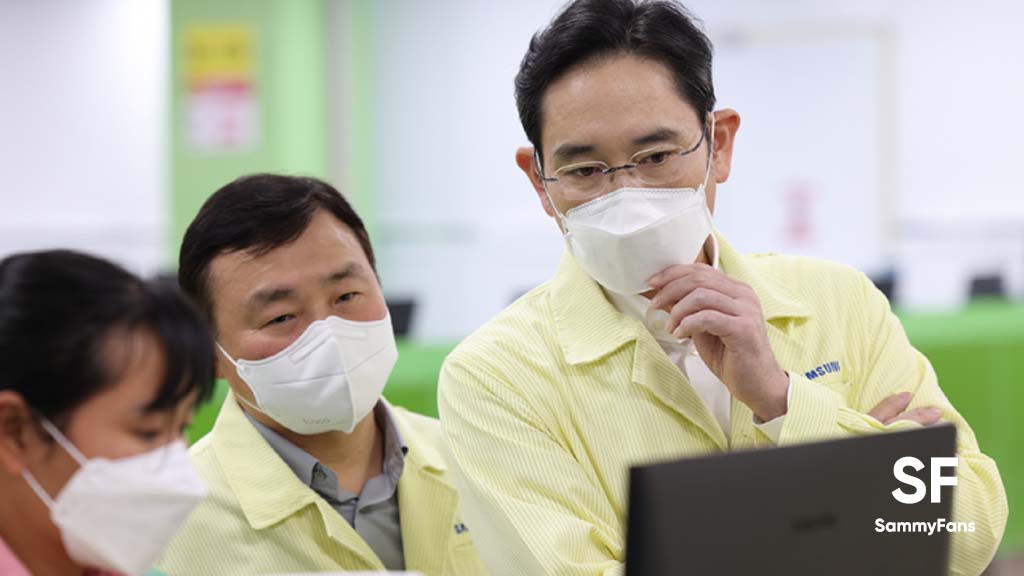News
Samsung chief attends R&D Center inauguration ceremony in Vietnam

On December 22, Samsung organized the inauguration ceremony of its new R&D Center in Vietnam. The company’s chairman Lee Jae-Yong visits Samsung Display Corporation (SDV) to inspect a display production plant in this R&D Center near Hanoi, Vietnam.
Samsung says that the company’s Research and Development Center in the country is the first large-scale comprehensive research center, with a land area of 11,603㎡ and a total floor area of 79,511㎡, established by a global company.
Follow Sammy Fans on Google News
This R&D center Samsung is built with 26 floors above ground and 3 floors underground. It has various welfare facilities for executives and employees, such as a Fitness center, Cafeteria, Rooftop garden, Club space, and State-of-the-art research facilities.
Join SammyFans on Telegram

This center includes more than 2,200 researchers, where smart devices will be deployed to study network technology, software, and others. Now the company is planning to strengthen the expertise of its R&D center by specializing in departments that are the core technologies of software for mobile devices including – Multimedia information processing and Wireless communication security.
Chairman Lee Jae-yong said – “Samsung R&D Center in Vietnam will contribute to strengthening Vietnam’s industrial competitiveness as well as enhancing friendly cooperation between the ROK and Vietnam.”
News
Google Pixel 9 to outshine Galaxy S24 with Samsung’s latest OLED
Samsung’s latest OLED tech could debut in the Google Pixel 9 series. The next-gen Pixel flagships would outshine Samsung’s S24 Ultra in terms of display. It’s almost confirmed that the Google Pixel 9 series will use OLED based on the Samsung M14 material.
Featuring Samsung M14 OLED, Google Pixel 9 will become the best phones in terms of display quality. More upgrades like new camera sensors and an ultrasonic fingerprint reader could also be included in the upcoming smartphones.
A source inside Google (via AndroidAuthority) disclosed key details. M14 is Samsung’s latest OLED display technology, set to foster the Pixel 9 series. The new iteration offers better brightness and longevity, giving the Pixel 9 an edge over current flagships.
Apple’s upcoming iPhone 16 Pro lineup will also induct Samsung’s M14 OLED. Meanwhile, the Galaxy S24 series, released earlier this year, features the M13-based OLED. There are various advantages of the upgraded panel coming in Pixel 9.
Google’s Pixel 9 would get a 1,800-nit display, while the Pro and Pro XL screens could peak at up to 2,050-nit. It’s worth noting that the company lists HDR values for full-screen brightness, so localized peak brightness values will be even higher.
Samsung could introduce the Galaxy S25 series in January next year. The company’s next-gen flagships will likely feature the new OLED display tech. Meanwhile, its biggest rivals are utilizing the latest display technology in 2024 itself.
Google is gradually increasing its presence in the global smartphone market. The company is seriously expanding its mobile business. The next year’s Pixel phones would be equipped with 3nm processors manufactured by TSMC.
News
Here’s why Google Messages replaced Samsung Messages on Galaxy devices

Samsung’s latest foldable phones come with Google Messages by default. The company has now revealed the reason behind this move on Galaxy devices. Samsung says Google Messages replaced Messages to foster RCS adoption.
According to AndroidAuthority, a source explained Samsung’s decision to switch to Google Messages as the default messaging app. The recently released Galaxy Z Flip 6 and Z Fold 6 come with Google Messages with RCS enabled by default.
Looks like promoting Google Messages on Galaxy devices will boost RCS adoption. Samsung Messages isn’t already installed on newer phones. However, one’s stopping you from getting it on your Galaxy from the Galaxy Store.
While many apps support the RCS feature, Google Messages offer the best user experience. Making it a default messaging app is an effort to boost the adoption of RCS tech. Apple is also preparing to bring RCS chat functionality to iMessage for iPhones.
What Samsung source said:
- Even if messaging apps follow the RCS standard, the availability may be limited depending on which app the other party uses. That’s why we decided to make Google Messages the common messaging platform, allowing Galaxy users to communicate more freely. This also enables a messaging app to respond to changes of the RCS standard more quickly and efficiently.
Previously, Samsung devices launched in the US came with two messaging apps. This time, the company has removed the Samsung Messages. During the first setup, users are notified that Google Messages is the default messaging application.
News
Samsung SmartThings gets ISO 27001 certified

Samsung SmartThings gained the international standard ISO/IEC 27001:2022 certification. The company has officially announced this major development in its global connected living platform.
SmartThings received ISO/IEC 27001:2022 certification for information security management systems. Certification reiterates that the SmartThings Cloud operates per international standards.
To be certified, a company has to meet the standard across a total of 123 detailed items, including policies for information security, access control for information assets, and incident response.
SmartThings receiving the ISO 27001 certification is the result of our sustained focus on the protection of information in a hyper-connected world with exponentially increasing intelligence.
Seungbum Choi, Executive Vice President and Head of Device Platform Center at Samsung Electronics said “this is just another step in our drive to fortify the platform’s security. We will continue to find new ways to ensure that SmartThings’ personalized services are provided even more safely.”

BSI Prez says that they have recognized that the operation capability and security level of Samsung SmartThings is excellent. It will further boost trust in the SmartThings platform and strengthen business competitiveness.
ISO 27001 is the leading global standard for ISMSs and was established by the International Organization for Standardization. It provides companies with guidance to manage the risks to information assets systematically and achieve information protection goals.










